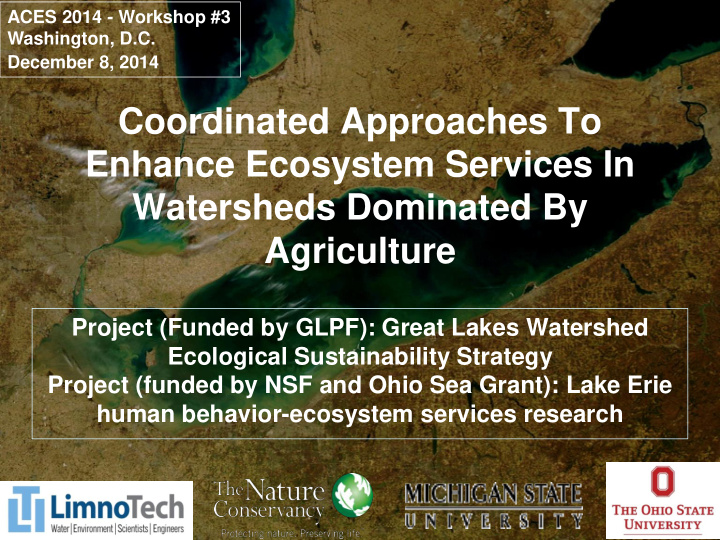



ACES 2014 - Workshop #3 Washington, D.C. December 8, 2014 Coordinated Approaches To Enhance Ecosystem Services In Watersheds Dominated By Agriculture Project (Funded by GLPF): Great Lakes Watershed Ecological Sustainability Strategy Project (funded by NSF and Ohio Sea Grant): Lake Erie human behavior-ecosystem services research
The Problem Photo by Tom Archer Flow-weighted SRP concentration 85 ug/L September 3, 2011 Photo by Tom Crail
The Cause-Effect Analysis Driving Factors Agricultural Meteorological Land Use Practices Events Nonpoint Source Solids and Nutrient Loading (SWAT) Eutrophication Fish and Benthos Symptoms in lake Impacts in Watershed • HABs Stream Network • Hypoxia • Sedimentation (Empirical Model) (WLEEM)
The Solution: Transactions Ecological Endpoints Ecological Endpoints Transactions Improved Conservation and Management Practices Candidate • Type of practice(s) Transactions Improved “Indices of • • Reverse auction Affected land area Biological Integrity” (IBIs) Flow, sediment, • Certification nutrient loading (various locations in Changes to • Drain management stream network) crops, tillage, drainage, etc. Final Evaluation Watershed Models Reduced Nutrient & of Transactions (SWAT) Sediment Delivery • Type (@ tributary mouths) • Location(s) • Funding Flow, sediment, Model nutrient loading Linkage Reduced Algal Production @ Waterville *Relative and Sediment Problems in ecological Western Lake Erie benefits Western Lake Erie • Microcystis blooms Ecosystem Model • Sedimentation/turbidity *Bid ranking (WLEEM) ($/lb algal reduction)
OSU Analysis: Lake Erie-land coupled human- natural systems model Farmer land Economic and social Policies management behavioral models decisions Spatial land use- P runoff from field P loadings to hydro watershed into watershed Lake Erie model (SWAT) Lake hydrodynamic- Changes in Value of lower food web ecosystem improved model services ecosystem services Costs of Benefits of Economic analysis policy ($) policy ($)
Workshop Talks Dennis McGrath, The Nature Conservancy. Overview of 1. Achievements from the Great Lakes Watershed Ecological Sustainability Strategy for Agricultural Watersheds in the Great Lakes Basin Todd Redder, LimnoTech. Linking Watershed and Coastal 2. Ecosystem Models to Assess Harmful Algal Bloom Production in the Western Lake Erie Basin Leah H. Palm-Forster, Michigan State University. Designing 3. Conservation Auctions for Aquatic Ecosystem Services in Agricultural Watersheds Randy Dell, The Nature Conservancy. Public Drain Fee 4. Reduction Program to Support Biological Watershed Outcomes Carrie Vollmer-Sanders, The Nature Conservancy. Lake Erie 5. 4R Nutrient Stewardship Certification: Water Quality Markets Wendong Zhang , The Ohio State University. Linking 6. agricultural land management decisions and Lake Erie ecosystem services using integrated ecological economic modeling
Roundtable Discussion with Panelists Discussion Questions: What are the top research areas/questions to focus 1. on in the next 2 years? 5 years? 10 years? What kinds of programs do we need to encourage 2. landowners to manage cropland in a way that improves water quality? Who (which organizations) should be engaging 3. with farmers to increase land stewardship? How should incentives be structured to maximize 4. participation in voluntary stewardship programs?
Recommend
More recommend